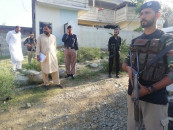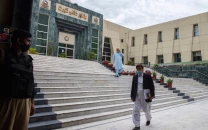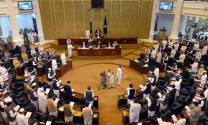Shoving the turtles aside for a bigger hut

Alvi, the planner for conservation and sustainable use of Karachi coast, said that the encroachments were along 280 kilometres of coastal land. Participants at the workshop, organised under the banner of Shehri-Citizens for a Better Environment (CBE), were informed about the threats to marine life and coastline.
“The Tasman spirit oil spill damaged marine life terribly, it forced turtles to shift their habitats,” Alvi said. According to him, land allotments along Hawksbay beach and Sandspit were made in the 1980s. But people were instructed to limit their huts to simple two-room accommodations and an area of 120 square yards. But as a drive down the sandy road along the Hawke’s Bay coast will show, the huts are many and massive.
They have been built without approval, Alvi said.
He also displayed slides on multimedia projectors to show the huts at Hawke’s Bay, built out of proportion to their allotted area. One such hut was a sprawling bungalow spread across an area of 1,000 square yards.
Speakers at the workshop maintained that development at the beaches had gone downhill from 2006 to 2009.
“The unplanned development should be stopped and proper planning and measures should be adopted,” said Dr Jamil Kazmi, the ex-chairman of the department of geography at Karachi University (KU). GIS mapping of the Karachi coast and a GIS-based analysis of marine life should also be carried out with the help of research, which can then be used in policy making, added Dr Kazmi.
Participants were briefed on projects being carried out to preserve and safeguard the ecology of the coastal areas. One such project, funded under the Indus for All Program’s Partnership Fund of World Wildlife Fund (WWF) Pakistan, is spread over a stretch of about 70 km, from Rehri Goth, Korangi to Cape Montze. According to Syed Ali Ghalib from Shehri, surveyed areas like Korangi creek, Hawke’s Bay and Cape Montze are becoming danger zones for rare migratory birds like the Rosy Pelican, green turtles, fishing cats and dolphins. Mangroves are also being cut down brutally and damage to these plants further exacerbates the situation since they are breeding grounds for many species of flora and fauna.
The beaches have become so polluted that human access is difficult there let alone access for turtles, said the former chairman of the environment studies department at KU, Saeed A Khan.
A lot of research and documentation has been carried out since 1990 but no actual work has been done for the preservation and conservation of the coastal areas’ ecology, he said.
Question and answer session
Transparency is a key requirement, said Kazmi. Too many projects, especially those involving foreign builders and developers, are launched without getting their Environment Impact Assessments (EIA) done.
Participants were also told how the Defence Housing Authority (DHA) was dumping waste water into the sea at two points, namely the Casino and Bilawal Chowrangi.
It was also discussed that the sea cannot be protected unless Lyari and Malir rivers are cleaned up.
A representative of Karachi Water and Sewerage Board (KWSB) said that the S-III project for sewerage treatment will be launched soon. At present only 70 MGD of 500 MGD water is treated before it is disposed off but after the project, more than 400 MGD waste will be treated, he said.
Published in The Express Tribune, July 6th, 2010.



















COMMENTS
Comments are moderated and generally will be posted if they are on-topic and not abusive.
For more information, please see our Comments FAQ